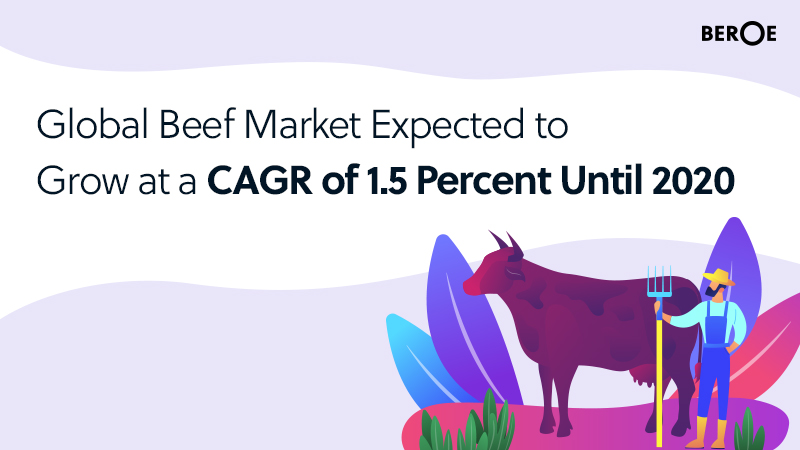Global Beef Market Expected to Grow at a CAGR of 1.5 Percent Until 2020, Says Beroe Inc
Source: PR Newswire

RALEIGH, North Carolina, October 14, 2019 - The global production of beef is expected to grow at a CAGR of 1.12 percent while the global consumption is estimated to grow at a CAGR of 1.03 percent, according to Beroe Inc., a procurement intelligence firm. The market is driven by increasing demands for beef due to greater awareness of the beef protein content.
Global beef production is driven by major beef producing regions like the US, Brazil, the European Union, China, India, and Australia, constituting approximately 71 percent of total production. The key beef consuming countries are the U.S., accounting for 20 percent of the global consumption, followed by the EU, Brazil, and China for 13 percent each, and India for 4 percent.
https://www.beroeinc.com/category-intelligence/beef-market/
Beroe, which is based in North Carolina, further stated that procurement experts can access this report on its recently launched market intelligence platform Beroe LiVE: live.beroeinc.com
Beef is emerging as a rich protein source and cheaper meat as compared to poultry, lamb, and pork driving the growth of the global beef market. The global beef market has been oversupplied in the past few years but with the growing demands is expected to move towards a balanced scenario by 2020. The trade war between the U.S. and China has reduced the supply of other forms of meat such as Pork to China, as a result of which there is greater demand for beef. The global supply of beef is increasing, supporting the growth of the market.
New trends in the global beef market are focused on increasing the weight of cattle before slaughter in a healthy manner. Feeds rich in protein are expensive, and add to the cost of production, but positive results have been observed by using crude protein in feeds. Insemination of cattle from the Aberdeen Angus breed of bulls produces calves of higher slaughter weight and higher beef content.
Key Findings:
- India will be the best sourcing destination for beef, due to the Pink revolution, where the number of slaughterhouses is increasing and subsidies are given by the government to these slaughterhouses. Also, a higher population of buffaloes, more than half the world’s population in India, helps in a higher supply of beef.
- The key engagement models are Over the Hooks, Paddock Sales, and Forward Contracts. Padlock sales and forward contracts are preferred by processors when purchase numbers are large and also to secure supply.
- The beef market in developed countries is consolidated, whereas in developing countries it is fragmented. In developing countries, fragmented suppliers fight for a higher revenue by artificially increasing carcass weight by inducing growth hormones to cattle.
- Major trading houses, like Tyson Foods, JBA, Cargill, and others, buy beef directly from aggregators and their farmers' network.
- Prices are likely to differ across the pricing mechanics even for the same pen of cattle. This is due to different information that is used to arrive at prices. The profit margin for a seller is calculated when he understands the pricing system used, the type of cattle sold and the impact of the net price quoted.
The research methodology adopted for the report included:
- Experts with twenty years of domain experience
- Interaction with buyers
- Inputs from supply chain partners
The principle cost drivers in the beef market are feed, accounting for 72 percent of the total costs, operating costs for 18 percent, and other costs for 10 percent. Beef prices exhibit seasonality due to dependency of biological and market fundamentals on climatic conditions with cattle spending most of the time in outdoor feedlots before reaching the market, including the last six months in the lifecycle at the farm. The weather conditions during that period may affect the cattle’s weight, and in turn, supply.
The report also includes:
Market Analysis:
- Global Market Outlook
- Current Market Size
- Demand–Supply Trends and Forecast
- Key End-use Industries
- Trade Dynamics
- Regional Market Outlook (US, Europe, and Asia)
- Current Market Size
- Demand–Supply Trends and Forecast
- Trade Dynamics
Industry Analysis:
- Industry Outlook (US, Europe, and Asia)
- Drivers and Constraints for the Industry
- Innovations
- Porter’s Five Forces Analysis
Cost and Pricing Analysis:
- Cost & Price Analysis (US, Europe, and Asia)
- Cost Drivers
- Cost Structure Analysis
- Price Forecast
Industry Best Practices:
- Key Sourcing Parameters
- Contract Structures
About Beroe Inc.:
Beroe is the world's leading provider of procurement intelligence and supplier compliance solutions. We provide critical market information and analysis that enables companies to make smart sourcing decisions—leading to lower costs, greater profits and reduced risk. Beroe has been providing these services for more than 13 years and currently works with more than 10,000 companies worldwide, including 400 of the Fortune 500 companies.
To learn more about Beroe Inc., please visit: http://www.beroeinc.com
Media Contact:
Rob McMurtrie
rob.mcmurtrie@beroe-inc.com
Related News
View all
Beroe introduces on-demand geopolitical risk analysis through PRISM enabling C-Suite to protect against ongoing supply chain disruptions

Beroe and Upply Combine their Expertise to Revolutionize Logistics Solutions
